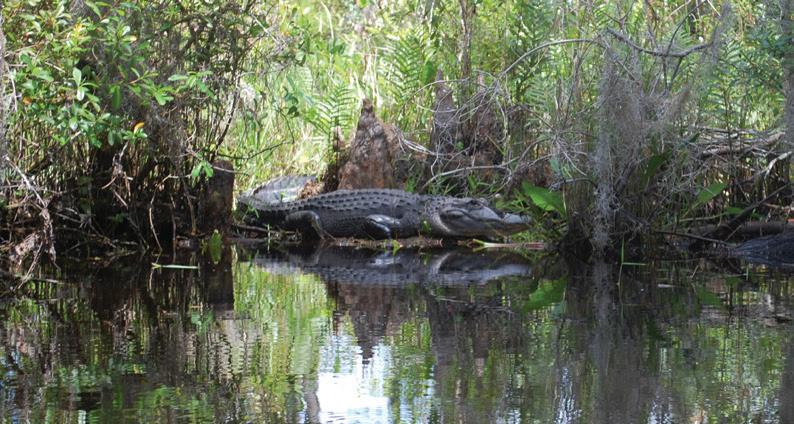
7 minute read
Kissing the Sea On the Lips
This article on oyster farming in South Carolina is a compilation of two articles orginally published in very early issues of Southern Tides. It is being reprinted in honor of our first oyster issue.
Article and Photos By Amy Thurman
Advertisement
Iarrived at Lady’s Island Oyster Farm on a breezy and overcast Friday afternoon to meet the owner, Frank Roberts, and learn about oysters. After a hectic week of meetings, ad sales calls, tracking down information, and entirely too much time in front of a computer, it was also an excuse to spend a few hours outside doing something fun. I had no idea I was in for a lot more.
The setting was, in part, familiar: huge live oaks bordering marsh grass, with the occasional piece of driftwood adding texture, a dock running out over the river, gulls swooping and laughing, and the earthy and soothing scent of pluff mud that eases tension in the shoulders better than any massage.
But there were a few distinguishing and less-familiar features as well, such as the cement-block former juke joint that’s being restored and given new life as a seafood shack, and the remnants of pilings from a dock that used to serve rum runners during Prohibition. I love a place with a colorful history, as this adds a bit of swagger to its step. Come to think of it, I enjoy people like that too.
Other distinguishing features were the hatchery shed and nursery station, where Lady’s Island oysters, known as “Single Ladies,” get their start in this world, and where Frank started me in my education of lowcountry oysters.

It all begins with a boy and a girl. Or in this case, a boy and five girls. After determining gender, a single male oyster and five females are isolated in a tub of river water at the appropriate temperature to trigger spawning. This setup begins at the same time oysters naturally spawn in the wild, usually in April, and runs through the summer until water temperatures drop in the fall.
After careful monitoring and critical maintenance of the spawn, called spat, for 19 to 21 days, the larvae reach “setting” age, when they attach to grains of finely ground oyster shell, roughly their same size of approximately 100 microns. To demonstrate, Frank placed a dropperful of larvae in a small dish and we looked at them with a microscope. Round, amber-colored, with a small dark “eye,” and a valve that resembled a tiny tadpole, this microscopic oyster was attached to a sliver of shell – as I watched, it flexed open, then closed, the movement that will one day open and close its shell as it filters nutrients.
Over the course of about four weeks, the oysters grow to around 1000 microns and are transitioned from hatchery to the nursery station into mesh-bottomed containers called silos. As the oysters grow, they’re moved to silos with increasingly wider mesh. When they’re about the size of a dime, they’re transferred into mesh bags, which are placed inside protective cages and moved to the river.
Safer from predators, such as boring sponges and crabs, than their wild cousins, and without the growth constrictions of having to cluster to survive, the survival rate of farmed oysters is significantly higher than in the wild. One half of one percent of wild oysters survive the larval stage, compared to a full six percent survival rate of farmed oysters. After the oyster larvae set, the survival odds increase. “We only lose about 15% after they set,” Roberts said. That loss can go as high as 90% in the wild. Given that a single oyster can produce over 100 million unfertilized eggs in a single spawning, this equates to significant increases in the oyster population with farming.
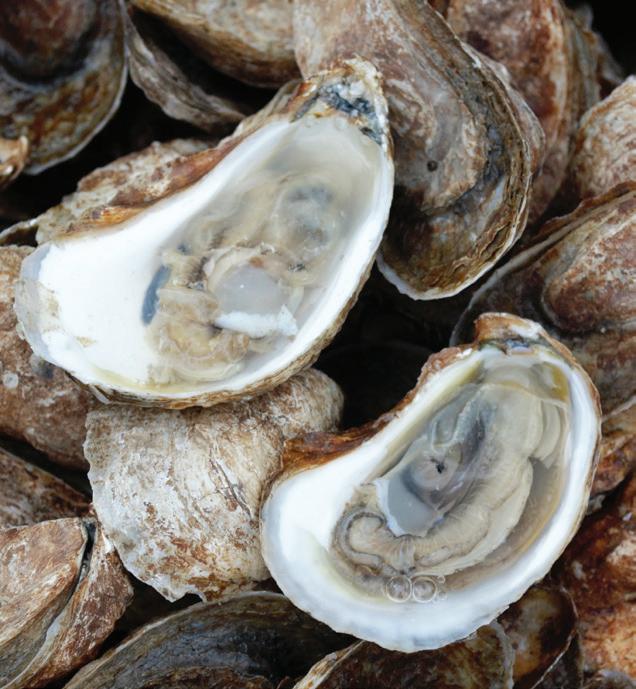
As these farmed oysters grow in the river, they’re periodically rotated into bags with larger mesh until they reach the perfect size of three inches, at which point, they’re ready to be delivered to restaurants. Wild oysters take about three years to reach that size, but Roberts and his crew have reduced this time; their farmed oysters reaching the legal 3-inch length in ten months.
Farmed fish and seafood get a lot of bad press in today’s world, largely due to health issues posed by products imported from countries with little or no oversight or regulations in the farming process. And while a lot of that bad press is well-deserved for imports, the same can’t be said of aquaculture in the U.S. In fact, the benefits of farmed seafood, such as oysters, have positive impacts on the environment, the economy, and individual health.
Although most of these farmed oysters will eventually make their way to someone’s table, the process is still highly beneficial to the environment. Filter feeders, including oysters, clams and mussels, are critical to the health of our coastal waters; a single oyster can filter up to 50 gallons of water per day.
“Shellfish aquaculture operations, such as the farms in South Carolina, can serve to improve water quality by helping to control phytoplankton and remove suspended solids from the water column,” said Dr. Peter Kingsley-Smith, a marine scientist with the South Carolina Department of Natural Resources (SCDNR). “Furthermore, by consuming algae, oysters have been shown to reduce nitrogen levels and may therefore play an important role in addressing eutrophication, or excess nutrients in the water that can lead to unwanted algal blooms.”
But filtering out all this bad gunk doesn’t mean the oyster consumes it or that contaminants are trapped in the shell. Instead, a sort of mucus is formed around the pollutants, which are then ejected and serve as food for other sea life.

Wild oyster rakes and the cages used with oyster farming also provide habitat for smaller marine life and feeding grounds for fish and crabs, offering prime fishing spots for local fisherman. In addition, farmed oysters take pressure off the wild stock, preventing over-harvesting, and allowing wild oyster rakes to continue to grow, thereby adding stability against erosion to water bottoms and shorelines.
This sustainable resource in turn has a positive impact on the economy. In South Carolina and other states practicing aquaculture, oyster sales to restaurants and individual consumers is on the rise, as is the sale of seed oysters to other farmers.
“We’ve increased production 30-40% every year,” said Roberts, “and we’re selling everything we produce.”
But what about the health benefits to humans? Unlike much imported seafood, which is often farmed in polluted ponds and fed a diet with growth and preservative additives, locally farmed oysters have the same diet as their wild cousins, with no additives, and live in their natural habitat. What you get when you open the shell is 100% natural. And you can’t beat ‘em for necessary nutrition. “Eating two oysters gives you all the minerals and nutrients you need for the day,” said Roberts, with a chuckle.
Loaded with Omega 3 fatty acids and zinc, they’re also excellent sources of protein, calcium, iron, and Vitamins B and C. The body absorbs these nutrients at a far higher rate when consumed naturally than when taken as a supplement. Some studies have also shown that eating oysters raises HDLs (good cholesterol) and lowers LDLs (the bad stuff). Consider the oyster nature’s way of giving you
Top: The hatchery shed at Lady's Island Oysters.
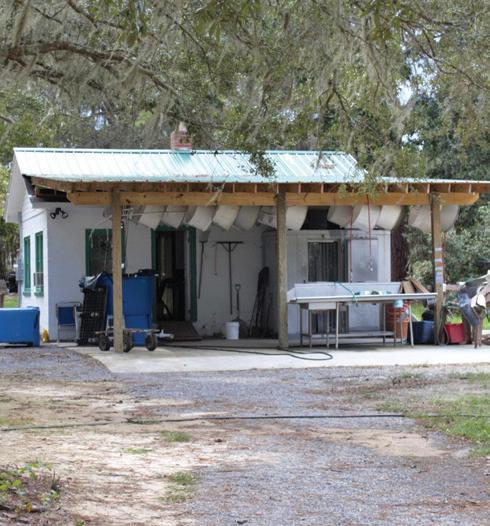
Middle: A dish of larval oysters just at the setting stage.
Left: The delicate and nearly translucent bit of white shell around the outside edge of the oyster, called frill, is new growth that in time builds up and hardens as the shell grows.

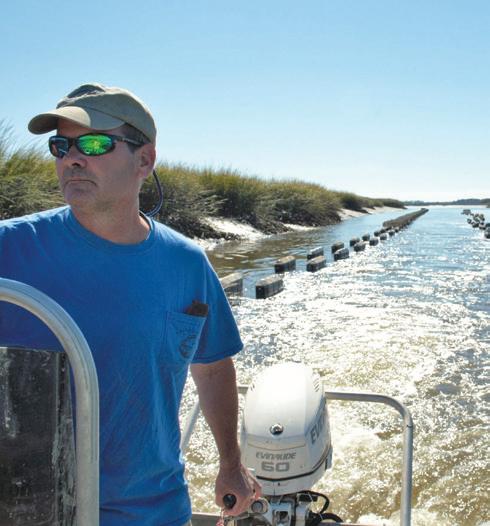
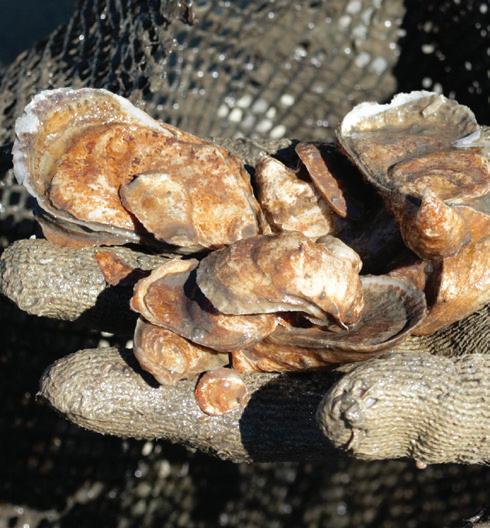
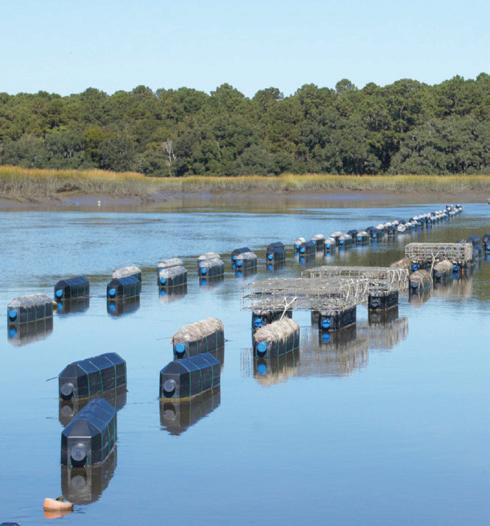
Opposite called green shelling. The algae aids in the setting process for new oysters, providing a textured surface to adhere to. Empty shells are also removed from the cluster, which helps the rake continue to grow by providing structure, and means less weight to carry back to the dock.
After gathering a bushel of wild oysters, we waded back to the boat and made our way back to the dock.
Once on land again, Frank and I sat in the shade of live oaks near the hatchery and talked oysters.
There’s a rich history associated with this shellfish. “Some of the first colonists to become wealthy made their money in the oyster industry. In Manhattan in the early 1800s, it wasn’t hot dog carts you saw on the streets of the city,” Frank said. “It was oyster carts.”
The industry continued to thrive until the Industrial Age. At that point, water pollution decimated the oyster harvest in most areas. “Now that the water’s being cleaned up, the industry and the traditions that go with it are making a comeback. Not one hatchery anywhere in the U.S. could fill all of their orders this year.” About 30% of the seed oysters Frank raises are sold to other oyster farmers in North and South Carolina. Demand exceeds supply, which is a healthy position to be in.
“Are you ready to sample some oysters?” Frank asked, as he pulled out a cooler and offered me a cold beer. (Oh yeah, I love my job!) Also in the cooler were several of his own “Single Lady Oysters,” named for the fact that they grow singly rather than in clusters like their wild cousins.
“See this nice pale off-white color?” he asked, opening the first one. “That’s a healthy oyster. And the liquor has a nice sheen to it. If you open an oyster and there’s no liquor in it, don’t eat it. If the liquor can drain out, contaminants can enter the shell.” Although he had two different sauces to compliment the oysters, I was instructed to go plain on the first one so all I would taste was the oyster. I have to confess, it had been a while since I’d had raw oysters and the last time I’d gotten one that was a little less than fresh. I was a bit worried that I might not be able to eat an oyster straight out of the shell again without that memory setting off my gag reflex. Though of course I wasn’t going to admit that to Frank!
But the oyster he handed me smelled clean and fresh, so I tipped it up and slid it into my mouth, straight from the shell.
“You have to chew it,” he said. “Chewing these oysters really brings their sweetness out.” So I chewed, and it was absolutely delicious. The memory of that bad oyster was instantly replaced and my worry vanished.
Next he suggested I try one with a homemade mignonette, a thin translucent sauce made with rice wine vinegar, white wine, diced shallots, lemon, and freshly ground black pepper. I’ve never eaten anything but cocktail sauce on oysters, so wasn’t sure what to expect, but it smelled wonderful and it definitely complimented the oyster even better than cocktail sauce.
We wrapped up the day sipping cold beer and eating cold oysters. I can honestly say they were the best oysters I’ve ever eaten. Many thanks to Frank Roberts for the education, the experience and the oysters!
Frank’s recommended reading: A Geography of Oysters: The Connoisseur’s Guide to Oyster Eating in North America, by Rowan Jacobsen.
Also on our reading list: The Big Oyster: History on the Half Shell by Mark Kurlansky









